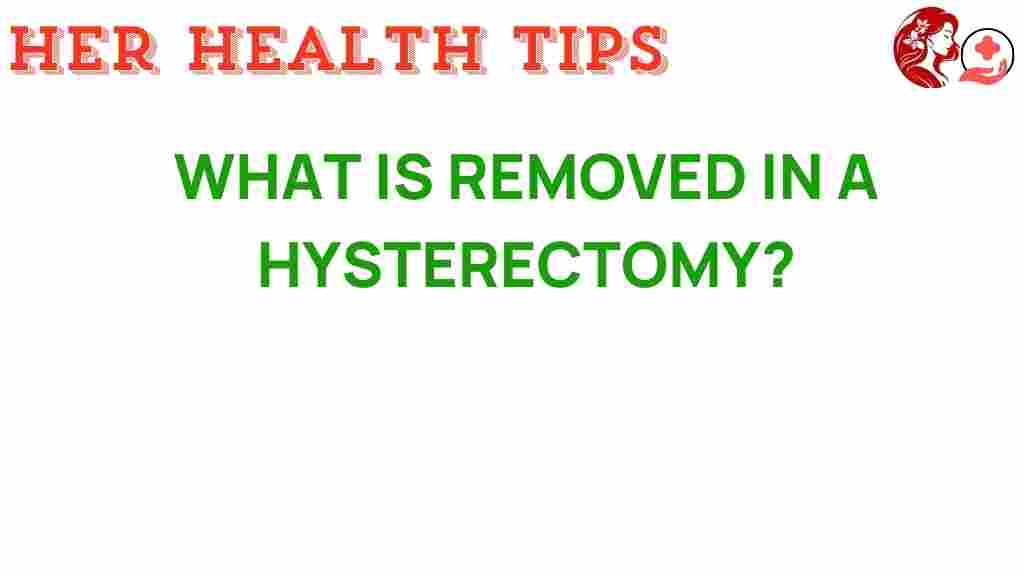Unraveling the Mystery: What is Removed in a Hysterectomy?
A hysterectomy is a significant surgical procedure that involves the removal of a woman’s uterus. Depending on the specific medical condition being treated, this operation can also involve the removal of other reproductive organs such as the ovaries and fallopian tubes. Understanding the details of what is removed during a hysterectomy is crucial for women’s health and can help patients make informed decisions about their surgical options.
Understanding Hysterectomy
A hysterectomy is often recommended for various medical reasons, including:
- Uterine fibroids
- Endometriosis
- Uterine prolapse
- Cancer of the uterus, cervix, or ovaries
- Chronic pelvic pain
Given the importance of the uterus in women’s health and reproductive functions, the decision to undergo a hysterectomy should be carefully considered and discussed with healthcare professionals.
Types of Hysterectomy
There are several types of hysterectomy procedures, and what is removed can vary:
- Total Hysterectomy: Removal of the entire uterus and cervix.
- Subtotal (or Partial) Hysterectomy: Removal of the uterus while leaving the cervix intact.
- Radical Hysterectomy: Removal of the uterus, cervix, surrounding tissue, and sometimes the ovaries and fallopian tubes, usually performed when cancer is present.
What Happens During a Hysterectomy Surgical Procedure?
The surgical procedure for a hysterectomy typically involves several steps:
Pre-operative Preparation
Before the surgery, patients usually undergo several evaluations, including:
- Medical history review
- Physical examination
- Blood tests
- Imaging studies (like ultrasounds or MRIs)
Patients are also advised on medications to avoid and dietary restrictions leading up to the surgery.
Anesthesia
On the day of the surgery, the patient will receive anesthesia. This can be either:
- General anesthesia (the patient is unconscious)
- Regional anesthesia (the lower body is numbed)
Incision and Removal
The surgeon makes an incision, which can be done in different ways:
- Abdominal Hysterectomy: An incision is made in the lower abdomen.
- Laparoscopic Hysterectomy: Small incisions are made, and instruments are inserted with the aid of a camera.
- Vaginal Hysterectomy: The uterus is removed through the vagina without an abdominal incision.
After the incision, the surgeon will carefully remove the uterus and any other necessary reproductive organs, depending on the type of hysterectomy being performed.
Post-operative Care and Recovery
After the procedure, patients are moved to a recovery room where medical staff will monitor their condition. Recovery time varies based on the type of hysterectomy:
- Abdominal Hysterectomy: Recovery can take 6 to 8 weeks.
- Laparoscopic Hysterectomy: Recovery is usually quicker, around 3 to 4 weeks.
- Vaginal Hysterectomy: Recovery is typically around 4 to 6 weeks.
Patients are generally advised to avoid strenuous activities and heavy lifting during the recovery period. Follow-up appointments with the healthcare provider are essential to monitor healing and address any concerns.
Risks and Benefits of Hysterectomy
Like any surgical procedure, a hysterectomy has its risks and benefits. Understanding these can help patients make informed decisions.
Benefits of Hysterectomy
Some of the benefits include:
- Relief from painful symptoms associated with fibroids or endometriosis
- Elimination of the risk of uterine cancer
- Improvement in quality of life and overall health
- Resolution of chronic pelvic pain
Risks of Hysterectomy
Potential risks associated with a hysterectomy include:
- Infection
- Heavy bleeding
- Blood clots
- Damage to surrounding organs
- Hormonal imbalances (if ovaries are removed)
It is crucial for patients to discuss their specific risks with their healthcare provider prior to the surgery.
Post-Hysterectomy Health Considerations
After a hysterectomy, women may experience various changes in their health, especially if the ovaries are removed:
Hormonal Changes
For women who have undergone a hysterectomy with removal of the ovaries, hormonal changes may occur, leading to:
- Hot flashes
- Night sweats
- Mood swings
- Vaginal dryness
Hormone replacement therapy (HRT) may be recommended to alleviate these symptoms, and patients should discuss the options with their healthcare provider.
Emotional Well-being
Many women report a range of emotions following a hysterectomy. It is essential to seek support during recovery to address feelings of loss, anxiety, or depression. Connecting with support groups or mental health professionals can be beneficial.
Frequently Asked Questions about Hysterectomy
1. Can a hysterectomy be reversed?
A hysterectomy is a permanent procedure, and reversing it is not possible. However, some women may consider alternatives if they are seeking relief from specific issues.
2. Will I still have periods after a hysterectomy?
If the uterus is completely removed, you will no longer have menstrual periods. However, if only the ovaries are removed, you may still have periods until menopause occurs.
3. What are the alternatives to a hysterectomy?
Alternatives may include medication for hormonal regulation, non-invasive procedures for fibroids, or other surgical options that preserve the uterus. Discussing these with a healthcare provider is essential.
Conclusion
A hysterectomy is a complex surgical procedure that can significantly impact a woman’s health. By understanding what is removed during the surgery, the types of hysterectomy, and the risks and benefits involved, women can make informed choices about their reproductive health.
For further reading on women’s health issues and surgical options, you can check out this resource. Additionally, for specific inquiries regarding your health, it is always best to consult with a healthcare professional.
Understanding the hysterectomy process can empower women to take charge of their health and make decisions that align with their personal needs and circumstances.
This article is in the category Reproductive and created by HerHealthTips Team
